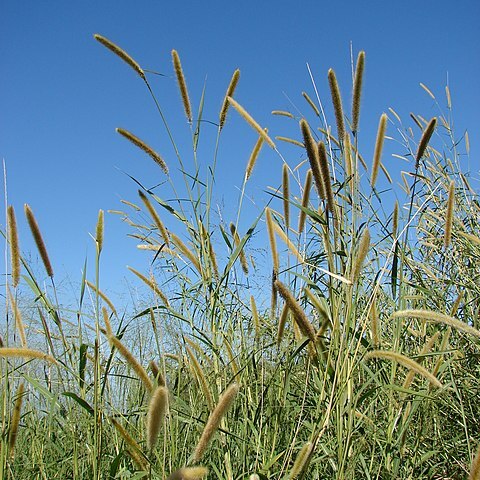Robust tufted perennial to 3 m or more, from stout rhizome to 6 mm diam. Leaf-sheath with fine ± appressed hairs. Ligule densely ciliate, hairs to 3 mm. Leaf-blade 30-75 × 2-3 cm, flat, with numerous fine appressed hairs. Culm internodes with fine hairs for some distance below inflorescence and long soft retrorse hairs above nodes. Panicle c. 14 × 2 cm, cylindric, spike-like with densely crowded spikelets; rachis villous. Spikelets 6.5-7.5 mm, solitary or in clusters of up to 5, straw-coloured, tinged reddish purple; involucre of numerous fine minutely scabrid bristles (c. 10 mm), some bristles plumose below and one much stouter and longer (to 20 mm). Lower glume 0, or minute, upper 0.5-1 mm, nerveless or 1-nerved, acute. Lower floret Ø: lemma < spikelet, 1-3-nerved, lanceolate, acute to acuminate; palea 0. Upper floret ☿: lemma = spikelet, 5-nerved, glabrous, acuminate; palea ≈ lemma and of similar texture; anthers c. 3 mm, penicillate; gynoecium: ovary 1-1.5 mm, stigma-styles to 9.5 mm; caryopsis not seen.
Tufted, robust perennial, 1.8-7.5 m high, often forms tall bamboo-like clumps; culms branched. Leaf blade 300-1200 x 10-40 mm, flat; ligule a fringe of hairs. Inflorescence a linear, robust, spike-like panicle, 70-300 mm long; rachis cylindrical, involucral stumps present or absent, hairy; involucre of up to 40 bristles; bristles unequal, outer glabrous and scabrid, inner few loosely plumose towards base, one inner bristle longer than rest; involucre enclosing 1-5 spikelets, one sessile and bisexual and rest pedicelled and male. Spikelet 4.5-7.0 x 1 mm; glumes unequal; lower glume absent; upper glume 1/4-1/2 length of spikelet, rarely absent. Florets 2; lower floret usually male, sometimes sterile, lemma 2/3 to as long as spikelet, 3-nerved; upper floret bisexual, lemma shining basally; anther apex bearing tiny tuft of hairs, rarely glabrous. Flowering time Jan.-June.
Tufted, robust perennial 1.8 to 7.5 m high, often forms tall bamboo-like clumps; culms branched. Leaf blade 300-1 200 x 10-40 mm, flat; ligule a fringe of hairs. Inflorescence 70-300 mm long, linear, robust; rachis cylindrical, short involucral stumps present or absent, hairy; involucre of up to 40 bristles, outer glabrous, scabrid, inner loosely plumose towards base; bristles unequal, one inner bristle longer than rest; involucre encloses 1-5 spikelets, one sessile and bisexual, the rest pedicelled and male. Spikelet 4.5-7.0 x 1 mm; lower glume absent; upper glume 1/4-1/2 the spikelet length, rarely absent; lemmas glabrous or scaberulous; lower floret usually male sometimes sterile, lemma 2/3 to as long as spikelet, 3-nerved; upper lemma shining basally; anther tips bearing a tiny tuft of hairs, rarely glabrous.
Robust perennial, often forming bamboo-like clumps; culms 1–6 m. high or more.. Leaf-blades up to 120 cm. long, 4 cm. wide.. Panicle linear, 7–30 cm. long; rhachis cylindrical, with or without short peduncle-stumps, pubescent; involucre enclosing 1–5 spikelets, one of them sessile and hermaphrodite, the others shortly pedicelled and ♂ (but scarcely different in appearance); bristles glabrous or obscurely ciliate, the longest 10–40 mm.. Spikelets lanceolate, 4.5–7 mm. long, glabrous; lower glume 0; upper glume 1/4–1/2 the length of the spikelet, rarely 0; lower lemma 2/3 to as long as the spikelet (rarely less), ♂ or barren, membranous, acuminate; upper lemma subcoriaceous and shining in the lower half, acuminate; anther tips bearing a tiny tuft of hairs (very rarely glabrous).. Fig. 156.
Panicle 7–30 cm. long, linear; rhachis cylindrical, with or without short peduncle stumps, pubescent; involucre enclosing 1–5 spikelets, one of them sessile and bisexual, the others shortly pedicelled and male (but scarcely different in appearance); bristles glabrous or obscurely ciliate, the longest 10–40 mm.
Perennial, tufted, up to 7.5 m high, often forming tall bamboo-like clumps. Leaf blades 30-400 mm long, 10-30 mm wide. Spikelets 4.5-7.0 mm long, 1 mm wide. Involucre of up to 40 bristles, inner few loosely plumose towards base; lower floret usually male.
A grass which keeps growing from year to year. It forms large clumps. It can grow 2-4 m tall. The leaf blades are 4 cm wide. The edges become very sharp. The flowers are dense and spike like. They are yellow, brown and purple.
Inferior glume suppressed, the superior 1/4–1/2 length of spikelet or rarely suppressed.
A robust perennial up to 8 m. high and 2.5 cm. diam. at the base
Anther tips bearing a tiny tuft of hairs (very rarely glabrous).
Superior lemma subcoriaceous and shining in the inferior half.
Inferior lemma 2/3 to as long as spikelet (rarely less).
Robust perennial, often forming bamboo-like clumps.
Leaf laminae up to 120 cm. long and 4 cm. wide.
Spikelets 4.5–7 mm. long.
Culms 1–6 m. high.

